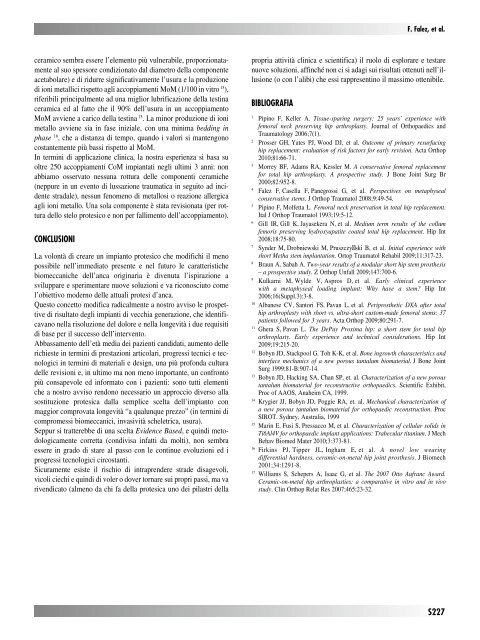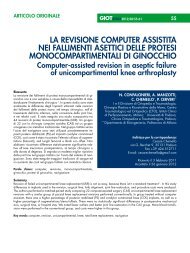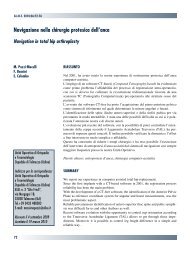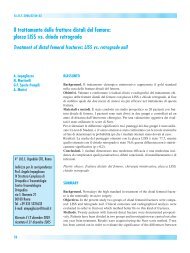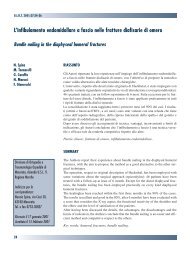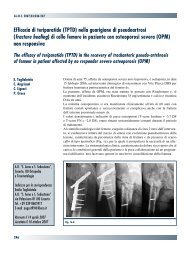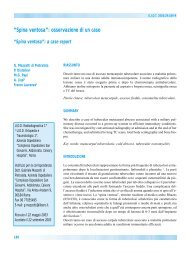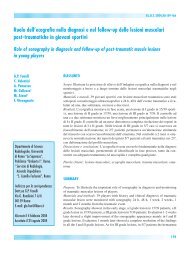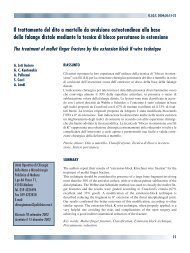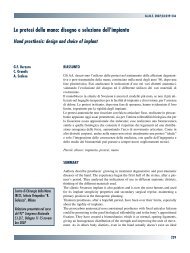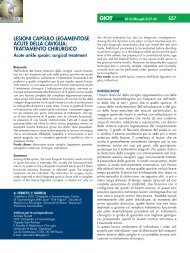30845 Suppl Giot.pdf - Giornale Italiano di Ortopedia e Traumatologia
30845 Suppl Giot.pdf - Giornale Italiano di Ortopedia e Traumatologia
30845 Suppl Giot.pdf - Giornale Italiano di Ortopedia e Traumatologia
Create successful ePaper yourself
Turn your PDF publications into a flip-book with our unique Google optimized e-Paper software.
ceramico sembra essere l’elemento più vulnerabile, proporzionatamente<br />
al suo spessore con<strong>di</strong>zionato dal <strong>di</strong>ametro della componente<br />
acetabolare) e <strong>di</strong> ridurre significativamente l’usura e la produzione<br />
<strong>di</strong> ioni metallici rispetto agli accoppiamenti MoM (1/100 in vitro 15 ),<br />
riferibili principalmente ad una miglior lubrificazione della testina<br />
ceramica ed al fatto che il 90% dell’usura in un accoppiamento<br />
MoM avviene a carico della testina 15 . La minor produzione <strong>di</strong> ioni<br />
metallo avviene sia in fase iniziale, con una minima bed<strong>di</strong>ng in<br />
phase 16 , che a <strong>di</strong>stanza <strong>di</strong> tempo, quando i valori si mantengono<br />
costantemente più bassi rispetto al MoM.<br />
In termini <strong>di</strong> applicazione clinica, la nostra esperienza si basa su<br />
oltre 250 accoppiamenti CoM impiantati negli ultimi 3 anni: non<br />
abbiamo osservato nessuna rottura delle componenti ceramiche<br />
(neppure in un evento <strong>di</strong> lussazione traumatica in seguito ad incidente<br />
stradale), nessun fenomeno <strong>di</strong> metallosi o reazione allergica<br />
agli ioni metallo. Una sola componente è stata revisionata (per rottura<br />
dello stelo protesico e non per fallimento dell’accoppiamento).<br />
CONCLuSIONI<br />
La volontà <strong>di</strong> creare un impianto protesico che mo<strong>di</strong>fichi il meno<br />
possibile nell’imme<strong>di</strong>ato presente e nel futuro le caratteristiche<br />
biomeccaniche dell’anca originaria è <strong>di</strong>venuta l’ispirazione a<br />
sviluppare e sperimentare nuove soluzioni e va riconosciuto come<br />
l’obiettivo moderno delle attuali protesi d’anca.<br />
Questo concetto mo<strong>di</strong>fica ra<strong>di</strong>calmente a nostro avviso le prospettive<br />
<strong>di</strong> risultato degli impianti <strong>di</strong> vecchia generazione, che identificavano<br />
nella risoluzione del dolore e nella longevità i due requisiti<br />
<strong>di</strong> base per il successo dell’intervento.<br />
Abbassamento dell’età me<strong>di</strong>a dei pazienti can<strong>di</strong>dati, aumento delle<br />
richieste in termini <strong>di</strong> prestazioni articolari, progressi tecnici e tecnologici<br />
in termini <strong>di</strong> materiali e design, una più profonda cultura<br />
delle revisioni e, in ultimo ma non meno importante, un confronto<br />
più consapevole ed informato con i pazienti: sono tutti elementi<br />
che a nostro avviso rendono necessario un approccio <strong>di</strong>verso alla<br />
sostituzione protesica dalla semplice scelta dell’impianto con<br />
maggior comprovata longevità “a qualunque prezzo” (in termini <strong>di</strong><br />
compromessi biomeccanici, invasività scheletrica, usura).<br />
Seppur si tratterebbe <strong>di</strong> una scelta Evidence Based, e quin<strong>di</strong> metodologicamente<br />
corretta (con<strong>di</strong>visa infatti da molti), non sembra<br />
essere in grado <strong>di</strong> stare al passo con le continue evoluzioni ed i<br />
progressi tecnologici circostanti.<br />
Sicuramente esiste il rischio <strong>di</strong> intraprendere strade <strong>di</strong>sagevoli,<br />
vicoli ciechi e quin<strong>di</strong> <strong>di</strong> voler o dover tornare sui propri passi, ma va<br />
riven<strong>di</strong>cato (almeno da chi fa della protesica uno dei pilastri della<br />
F. Falez, et al.<br />
propria attività clinica e scientifica) il ruolo <strong>di</strong> esplorare e testare<br />
nuove soluzioni, affinché non ci si adagi sui risultati ottenuti nell’illusione<br />
(o con l’alibi) che essi rappresentino il massimo ottenibile.<br />
BIBLIOGraFIa<br />
1 Pipino F, Keller A. Tissue-sparing surgery: 25 years’ experience with<br />
femoral neck preserving hip arthroplasty. Journal of Orthopae<strong>di</strong>cs and<br />
Traumatology 2006;7(1).<br />
2 Prosser GH, Yates PJ, Wood DJ, et al. Outcome of primary resurfacing<br />
hip replacement: evaluation of risk factors for early revision. Acta Orthop<br />
2010;81:66-71.<br />
3 Morrey BF, Adams RA, Kessler M. A conservative femoral replacement<br />
for total hip arthroplasty. A prospective study. J Bone Joint Surg Br<br />
2000;82:952-8.<br />
4 Falez F, Casella F, Panegrossi G, et al. Perspectives on metaphyseal<br />
conservative stems. J Orthop Traumatol 2008;9:49-54.<br />
5 Pipino F, Molfetta L. Femoral neck preservation in total hip replacement.<br />
Ital J Orthop Traumatol 1993;19:5-12.<br />
6 Gill IR, Gill K, Jayasekera N, et al. Me<strong>di</strong>um term results of the collum<br />
femoris preserving hydroxyapatite coated total hip replacement. Hip Int<br />
2008;18:75-80.<br />
7 Synder M, Drobniewski M, Pruszczyński B, et al. Initial experience with<br />
short Metha stem implantation. Ortop Traumatol Rehabil 2009;11:317-23.<br />
8 Braun A, Sabah A. Two-year results of a modular short hip stem prosthesis<br />
– a prospective study. Z Orthop Unfall 2009;147:700-6.<br />
9 Kulkarni M, Wylde V, Aspros D, et al. Early clinical experience<br />
with a metaphyseal loa<strong>di</strong>ng implant: Why have a stem? Hip Int<br />
2006;16(<strong>Suppl</strong>.3):3-8.<br />
10 Albanese CV, Santori FS, Pavan L, et al. Periprosthetic DXA after total<br />
hip arthroplasty with short vs. ultra-short custom-made femoral stems: 37<br />
patients followed for 3 years. Acta Orthop 2009;80:291-7.<br />
11 Ghera S, Pavan L. The DePuy Proxima hip: a short stem for total hip<br />
arthroplasty. Early experience and technical considerations. Hip Int<br />
2009;19:215-20.<br />
12 Bobyn JD, Stackpool G, Toh K-K, et al. Bone ingrowth characteristics and<br />
interface mechanics of a new porous tantalum biomaterial. J Bone Joint<br />
Surg 1999;81-B:907-14.<br />
13 Bobyn JD, Hacking SA, Chan SP, et. al. Characterization of a new porous<br />
tantalum biomaterial for reconstructive orthopae<strong>di</strong>cs. Scientific Exhibit,<br />
Proc of AAOS, Anaheim CA, 1999.<br />
14 Krygier JJ, Bobyn JD, Poggie RA, et. al. Mechanical characterization of<br />
a new porous tantalum biomaterial for orthopae<strong>di</strong>c reconstruction. Proc<br />
SIROT. Sydney, Australia, 1999<br />
15 Marin E, Fusi S, Pressacco M, et al. Characterization of cellular solids in<br />
Ti6Al4V for orthopae<strong>di</strong>c implant applications: Trabecular titanium. J Mech<br />
Behav Biomed Mater 2010;3:373-81.<br />
16 Firkins PJ, Tipper JL, Ingham E, et al. A novel low wearing<br />
<strong>di</strong>fferential hardness, ceramic-on-metal hip joint prosthesis. J Biomech<br />
2001;34:1291-8.<br />
17 Williams S, Schepers A, Isaac G, et al. The 2007 Otto Aufranc Award.<br />
Ceramic-on-metal hip arthroplasties: a comparative in vitro and in vivo<br />
study. Clin Orthop Relat Res 2007;465:23-32.<br />
S227


